When you should not drink alcohol
Drinking alcohol in the wrong way is dangerous. Please follow the rules and drink correctly.
Never drink and drive
When you drink alcohol, the concentration of alcohol in your bloodstream increases, which can lead to paralysis of the central nervous system, and a decline in motor function, cognitive ability, situational judgment and concentration, as well as a dulling of the sense of balance, which can make it difficult to make accurate judgments quickly and can lead to delayed braking and steering or even reckless driving.
Also, it takes about 30 minutes to 2 hours for alcohol to affect the brain. Because the effects of intoxication come later, you may think that you are sober when you are drunk, or you may think that a short rest will be enough. If you plan to drive the next day, it is important to consider the amount of alcohol you drink and the time you drink it. If you drink alcohol late at night, there is a possibility that alcohol will remain in your body the next morning, so please refrain from driving.
Overconfidence can lead to tragedy, so never drive after drinking alcohol.
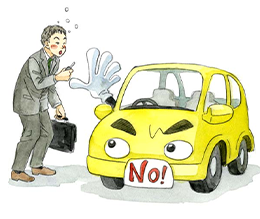
Laws and reality of drunk driving
Even though drunk driving is prohibited by law (Article 65 of the Road Traffic Law), it continues to occur.
In 2021, there were 2,198 traffic accidents caused by drunk drivers, a decrease from the previous year, and of these, there were 152 fatal accidents, also a decrease from the previous year. The number of fatal accidents caused by drunk driving has been decreasing significantly since 2002 due to stricter punishments for drunk driving and a growing social awareness of the need to eradicate drunk driving. Still, the rate of decrease has slowed since 2008.
In addition, the fatality rate for drunk driving is extremely high, at around 9 times that of non-drunk drivers, showing that traffic accidents caused by drunk driving are hazardous and can easily lead to fatalities.
Not only the driver but also any passengers who were aware that the driver had been drinking will be punished. Furthermore, if you drive a car after drinking alcohol at a restaurant, not only the driver and passengers but also the restaurant (the person who served the alcohol) will be punished.
If you see someone around you who has been drinking, please remember not to let them drive.
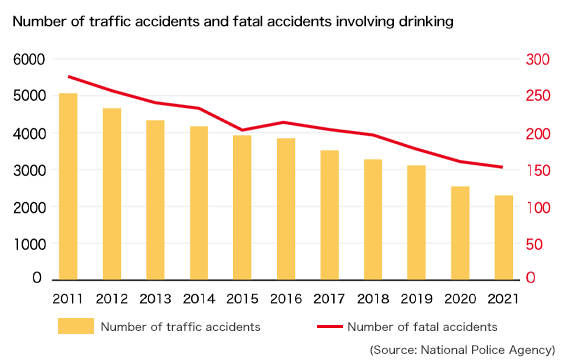
Act on Punishment of Acts Causing Death or Injury by Persons Driving Vehicles
Article 3 (Newly established as dangerous driving causing death or injury)
“A person drives a car while under the influence of alcohol or drugs, or a disease that may impair driving, and this leads to impaired driving and causes death or injury to another person is subject to…”
Penalty: Lethal: imprisonment with work for up to 15 years (maximum of 20 years) / Non-fatal: imprisonment with work for up to 15 years
-
*The previous “Dangerous Driving Causing Death or Injury” section of the Criminal Code has been replaced by the “Act on Punishment of Acts Causing Death or Injury by Driving a Vehicle”, which strengthens penalties for malicious and dangerous drivers by adding new categories to the Dangerous Driving Causing Death or Injury section. (This act came into force on May 20th, 2014)
Road Traffic Law
On June 1st, 2009, the Road Traffic Law was revised to strengthen administrative penalties for drunk driving. The main points of the strengthening are significantly higher penalty points for violations such as drunken driving and driving under the influence, and an extension of the driving suspension period.
Standards for the control of drunk driving
-
Drunk driving: Driving while intoxicated, such as being unable to walk straight
-
Driving under the influence: Driving while having a certain amount of alcohol in the body, even if not drunk
Relationship between alcohol concentration in breath and alcohol concentration in blood
At police checkpoints, medical tests such as blood tests are not possible, so the level of intoxication is checked by measuring the alcohol concentration in the breath. In the following table, the alcohol concentration in the breath that constitutes a violation is converted to the alcohol concentration in the blood.
Even if you have drunk half a bottle of beer, you will be considered to be driving under the influence. Even if you are in the sober phase of intoxication, it is considered extremely dangerous to drive.
(Please note) This table does not aim to indicate the amount of alcohol consumption that does not constitute a violation. It is intended to help you understand how strict the standards for the control of drunk driving are. In fact, it is known that even half the amount shown above (blood alcohol concentration of 0.15mg/ml, 0.07mg in 1 liter of exhaled breath) can affect your ability to drive. When driving, you must not drink even a drop of alcohol.
| Exhaled breath | 0.15mg or more per liter | 0.25mg or more per liter |
|---|---|---|
| Blood | 0.3mg or more per milliliter (0.03% or more) 0.5mg or more per milliliter |
(0.05% or more) |
| Exhaled breath | Amount of alcohol consumed | (number of drinks) 1 drink or more 2 drinks or more |
Standard drink size
-
1 drink = 1 single whisky glass
-
2 drinks = 1 bottle of beer, 1 go of sake
Drinking and driving on a bicycle is also prohibited
Drunk driving is not just a problem for cars. It is also against the law to ride a bicycle after drinking alcohol.
As bicycles are considered light vehicles, riding a bicycle after drinking alcohol is punishable by up to 5 years in prison or a fine of up to 1 million yen, just like driving a car.
If you have even one sip of alcohol, you must not ride a bicycle.
Mixing alcohol with medications and drinking while exercising or bathing are also dangerous.
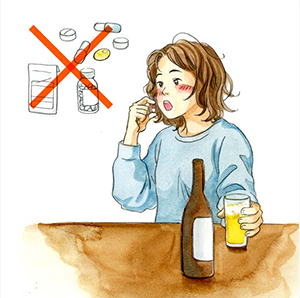
Mixing with medications
In the body, the breakdown of alcohol takes priority, and the medication remains in the bloodstream for a long time without being broken down. This can cause the medication to have a more substantial effect, and in some cases, can lead to dangerous conditions such as coma or stomach ulcers.
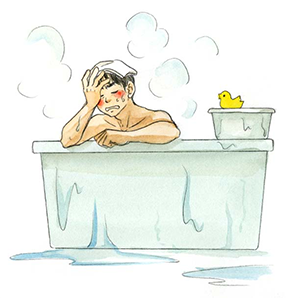
When playing sports, climbing mountains, swimming, etc.
Drinking alcohol before, during, or immediately after sports such as swimming, tennis, mountain climbing, or skiing can throw off your sense of balance and put a strain on your heart. Also, drinking alcohol in the hot sun can cause heatstroke and dehydration, so be careful.
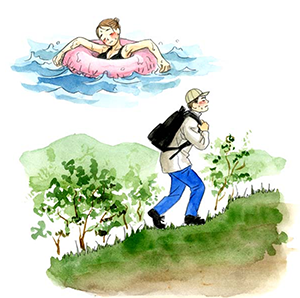
Bathing and saunas
Bathing or using a sauna while drinking alcohol or immediately after drinking alcohol can raise your blood pressure, and depending on your physical condition, it could trigger a stroke.
Be careful even with that one drink after your bath.